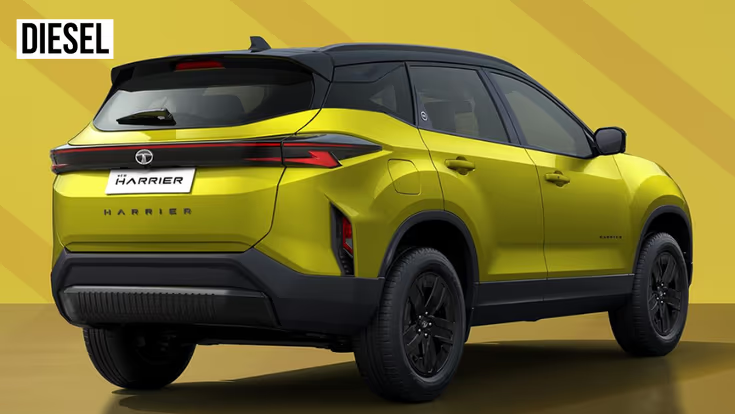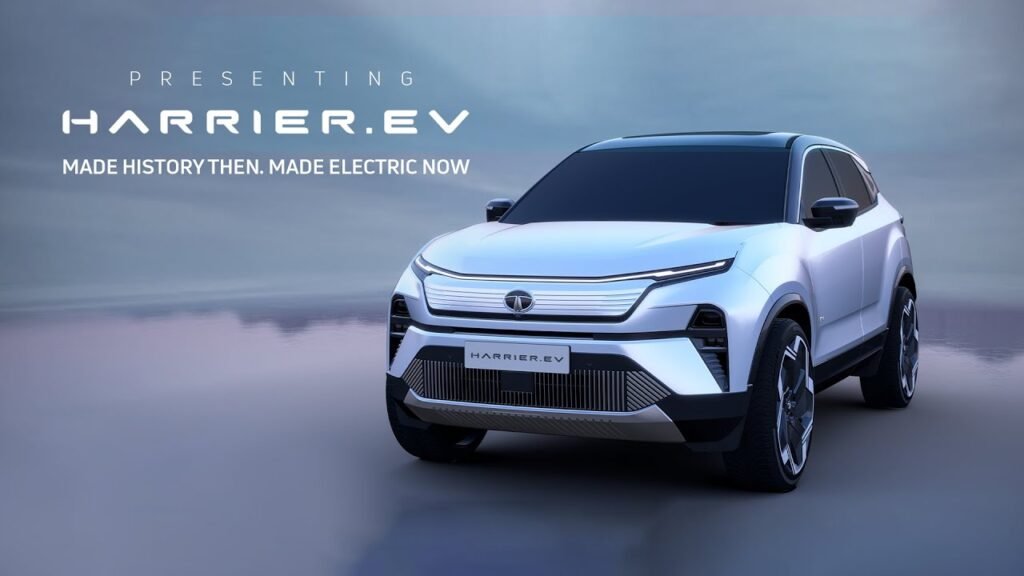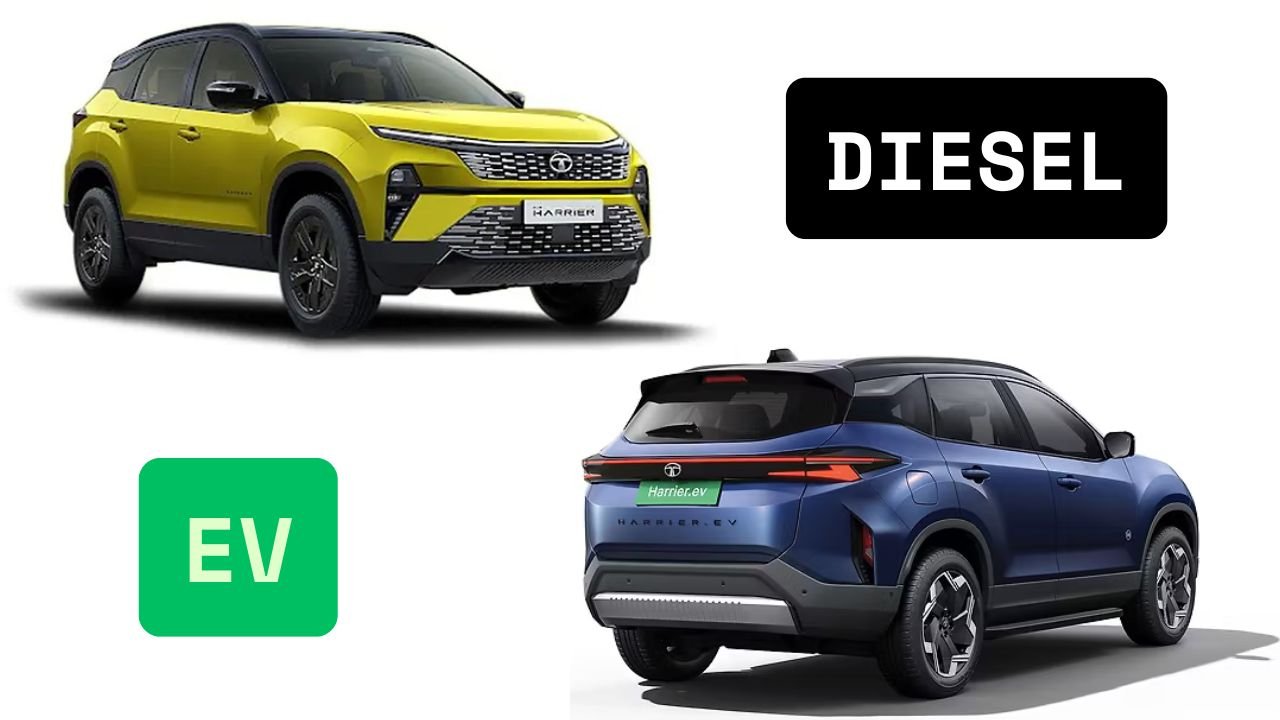Tata Motors has taken a major leap into the electric SUV segment with the launch of the Harrier EV, marking its most advanced, feature-rich and powerful electric vehicle to date. While the EV variant bears a strong visual resemblance to the diesel-powered Harrier, the two models significantly diverge in terms of technology, powertrain, and functionality. Here’s a detailed look at how these two versions compare.
Design Language and Exterior Differences

Despite sharing the same basic silhouette and stance, the Harrier EV brings some subtle design updates. It replaces the traditional grille with a closed-off panel, features a reworked front bumper, silver bash plates, and gets EV-specific badging. Its alloy wheels are designed for better aerodynamics. Nonetheless, core design cues like the upright posture, blade-style LED DRLs, vertically stacked headlamps, continuous rear light bar, and integrated roof spoiler remain the same across both models.
When it comes to colour palette, the Harrier diesel offers eight options including Sunlit Yellow, Ash Grey and Coral Red. The EV narrows this to five shades – Empowered Oxide, Pristine White, Nainital Nocturne, Matte Stealth Black, and Pure Grey. Interestingly, the electric Harrier is 2mm longer and 22mm taller, though both share the same 2,741mm wheelbase.
Cabin Layout and Interior Enhancements
The interior of both variants is nearly identical in terms of layout. Both SUVs sport the same dashboard design, four-spoke steering wheel with illuminated logo, floating infotainment screen, and a digital instrument cluster. However, the Harrier EV upgrades the screen to a 14.53-inch Samsung Neo QLED unit, a first-of-its-kind globally, compared to the 12.3-inch screen on the diesel model.
One unique feature of the Harrier EV is its all-digital IRVM that includes a built-in dashcam capable of recording both front and rear views. The EV also offers more boot space – 502 litres plus a frunk while the diesel offers 445 litres. It should be noted that the diesel’s capacity is measured up to the parcel tray, whereas the EV’s is measured to the roof.
Advanced Features and New-Age Architecture

A significant differentiator is the Harrier EV’s TiDAL (Tata Intelligent Digital Architecture Layer), which supports advanced features like over-the-air updates, voice commands, a 540-degree camera system, and Level 2 ADAS. Tata claims that the ADAS has been adapted for Indian road conditions.
The EV also introduces semi-autonomous features like auto-park assist and summon mode, allowing it to self-navigate tight spaces. A unique DrivePay system, which facilitates UPI-based transactions directly from the car for tolls and EV charging, reduces dependency on smartphones. It also supports V2L and V2V functionalities, expanding its practicality.
Both models share several features such as a panoramic sunroof, ventilated and powered front seats, ambient lighting, a wireless charger, rear window sunshades, dual-zone climate control, and a powered tailgate. The EV takes rear passenger comfort up a notch with a powered Boss Mode seat function for the front passenger.
Platform and Powertrain Comparison

Built on a re-engineered version of the diesel Harrier’s Omega architecture – dubbed Acti.ev – the Harrier EV offers two battery choices: 65kWh and 75kWh. The smaller pack powers a rear-mounted 238hp motor. The larger battery adds a 158hp front motor, resulting in an all-wheel-drive setup with a combined 313hp and 504Nm torque. This version also includes features like four-level regenerative braking and a Drift mode.
Unlike the EV, the Harrier diesel remains front-wheel drive and is powered by a 2.0-litre turbo-diesel engine producing 170hp and 350Nm. It is mated to either a 6-speed manual or a 6-speed automatic gearbox. Performance-wise, the diesel variant takes 11–12 seconds to reach 100kmph, whereas the EV AWD version does it in just 6.3 seconds with Boost mode enabled. Drive modes also differ slightly: the diesel and RWD EV share Eco, City, and Sport, while the AWD EV adds Boost mode.
Range and Charging Capabilities
The Harrier EV (75kWh AWD) has an MIDC-certified range of 622km, while the RWD version offers a slightly higher 627km. Tata hasn’t yet shared figures for the 65kWh battery model. Charging from 10% to 100% takes 10.7 hours using a 7.2kW AC charger. Meanwhile, a 120kW DC fast charger can replenish 20% to 80% in just 25 minutes, offering up to 250km of range in a 15-minute charge.
Off-Roading and Suspension Tweaks
The AWD Harrier EV brings back off-road capabilities that have been missing from Tata cars for over five years. It introduces a multi-link rear suspension with frequency-dependent dampers and offers six terrain modes – Normal, Snow/Grass, Mud-Ruts, Sand, Rock Crawl, and Custom compared to three in the diesel version. There’s also a “Transparent Mode” that streams a live feed of the terrain under the vehicle, aiding in off-roading scenarios.
Pricing and Variants Breakdown
The Harrier diesel is available in a whopping 16 variants, including trims like Smart, Pure, Adventure, Fearless, and special Dark and Stealth Editions. Prices start at ₹15 lakh and go up to ₹26.50 lakh.
On the other hand, the Harrier EV has launched with just three trims: Adventure, Fearless, and Empowered. Currently, Tata has only revealed the price of the Adventure variant at ₹21.49 lakh (introductory). The top-end Empowered trim is expected to surpass the diesel variant’s pricing. To sweeten the deal, Tata is offering a lifetime battery warranty for EV buyers.
While the diesel Harrier continues to offer robust performance and a wide variety of trims, the electric Harrier significantly raises the bar in terms of innovation, sustainability, and features. With better acceleration, longer range, more off-road capabilities, and a futuristic tech suite, the Harrier EV redefines Tata’s SUV game. For buyers choosing between the two, the decision hinges on personal preference—diesel’s practicality versus the EV’s modern appeal.

